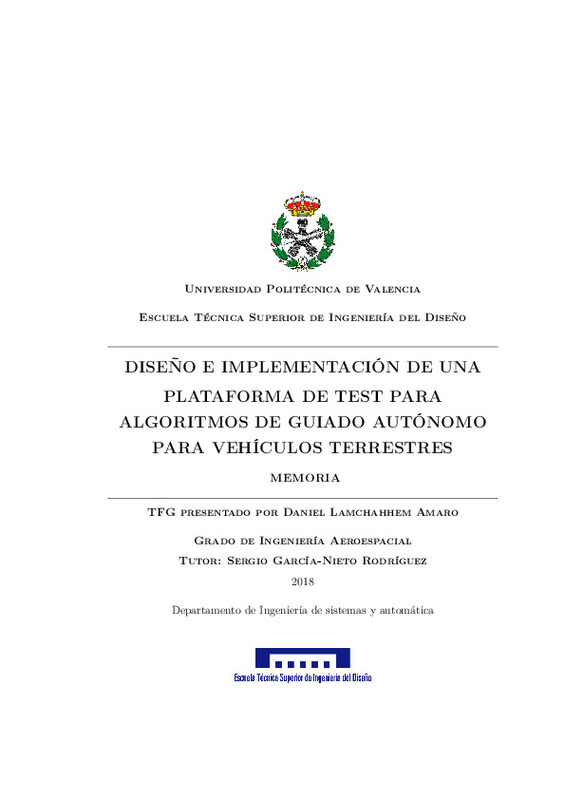JavaScript is disabled for your browser. Some features of this site may not work without it.
Buscar en RiuNet
Listar
Mi cuenta
Estadísticas
Ayuda RiuNet
Admin. UPV
Diseño e implementación de una plataforma de test para algoritmos de guiado autónomo para vehículos terrestres
Mostrar el registro sencillo del ítem
Ficheros en el ítem
| dc.contributor.advisor | García-Nieto Rodríguez, Sergio
|
es_ES |
| dc.contributor.author | Lamchahhem Amaro, Daniel
|
es_ES |
| dc.date.accessioned | 2018-07-30T08:01:44Z | |
| dc.date.available | 2018-07-30T08:01:44Z | |
| dc.date.created | 2018-07-03 | |
| dc.date.issued | 2018-07-30 | es_ES |
| dc.identifier.uri | http://hdl.handle.net/10251/106382 | |
| dc.description.abstract | [EN] This project consists of the realization of an algorithm for the autonomous guiding of terrestral vehicles based on different situations. The software of the project is made with Labview, the designed code will be used to share flux information between the hardware (terrestral vehicle and the computation system). From the computer the user will be able to select if they desire manual driving or an autonomous one. In case of manual driving the vehicle will be guided manually, with the keyboard. In the second case the terrestral vehicle, using artificial vision, will receive real time information about the road in order to be able to process the image and take control if necessary. At the same time, based on the same artificial vision, information about whether the driver is tired or not will be known, in order to take the control to manage the situation if it is needed. | es_ES |
| dc.description.abstract | [ES] El presente proyecto consiste en la realización de un algoritmo para guiado autónomo de vehículos terrestres presentado bajo varios escenarios de conducción. La parte de software del proyecto será realizado con la herramienta LabView, el código diseñado servirá para realizar flujo de información entre el hardware (el vehículo terrestre y el sistema de computación). Desde el ordenador se podrá seleccionar si se desea una conducción manual o autónoma. En el caso del primer tipo de conducción el vehículo será dirigido manualmente con el teclado del ordenado. En el segundo caso el vehículo terrestre mediante visión artificial recibirá información en tiempo real del carril para poder procesar la imagen y realizar el control necesario. A su vez, con el mismo principio de visión artificial, se conocerá en todo momento el nivel de fatiga del conductor, para en el caso de detectar un nivel excesivo, tomar el control del vehículo y realizar la maniobra pertinente | es_ES |
| dc.format.extent | 136 | es_ES |
| dc.language | Español | es_ES |
| dc.publisher | Universitat Politècnica de València | es_ES |
| dc.rights | Reserva de todos los derechos | es_ES |
| dc.subject | Control | es_ES |
| dc.subject | Guiado | es_ES |
| dc.subject | Vehículos Autónomos | es_ES |
| dc.subject | Sistemas Empotrados | es_ES |
| dc.subject | Sistemas de Tiempo Real | es_ES |
| dc.subject | Labview | es_ES |
| dc.subject | Reconocimiento de imagen. | es_ES |
| dc.subject.classification | INGENIERIA DE SISTEMAS Y AUTOMATICA | es_ES |
| dc.subject.other | Grado en Ingeniería Aeroespacial-Grau en Enginyeria Aeroespacial | es_ES |
| dc.title | Diseño e implementación de una plataforma de test para algoritmos de guiado autónomo para vehículos terrestres | es_ES |
| dc.type | Proyecto/Trabajo fin de carrera/grado | es_ES |
| dc.rights.accessRights | Abierto | es_ES |
| dc.contributor.affiliation | Universitat Politècnica de València. Departamento de Ingeniería de Sistemas y Automática - Departament d'Enginyeria de Sistemes i Automàtica | es_ES |
| dc.contributor.affiliation | Universitat Politècnica de València. Escuela Técnica Superior de Ingeniería del Diseño - Escola Tècnica Superior d'Enginyeria del Disseny | es_ES |
| dc.description.bibliographicCitation | Lamchahhem Amaro, D. (2018). Diseño e implementación de una plataforma de test para algoritmos de guiado autónomo para vehículos terrestres. Universitat Politècnica de València. http://hdl.handle.net/10251/106382 | es_ES |
| dc.description.accrualMethod | TFGM | es_ES |
| dc.relation.pasarela | TFGM\87663 | es_ES |
Este ítem aparece en la(s) siguiente(s) colección(ones)
-
ETSID - Trabajos académicos [8709]
Escuela Técnica Superior de Ingeniería del Diseño





![MS Powerpoint file [PP]](/themes/UPV/images/mspowerpoint.png)

